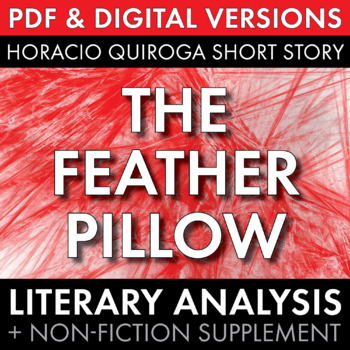The Feather Pillow Horacio Quiroga, Lit. Analysis + Non-Fiction PDF & Google App
- PDF
- Google Apps™

What educators are saying
Description
Introduce your students to Horacio Quiroga, a master of suspense who will forever change the way they look at their pillows and mattresses with his famous story of everyday horror, “The Feather Pillow.”
This 9-page PDF (with Google Drive version of all student handouts) includes:
• Suggested lesson procedure page
• Full text of “The Feather Pillow,” a wonderfully creepy public domain short story by Uruguayan writer Horacio Quiroga. (English translation)
• Handout of questions/discussion starters for students to answer solo or in small groups after reading the story. The questions will require them to dig back into the text and their own minds to find the answers.
• Full-text informational article about the real-life terror of sleep paralysis.
• Handout of questions/discussion starters for students to answer solo or in small groups after reading the non-fiction article.
• Detailed answer keys for both the short story and informational text assignments to make grading easy and help you guide the full-class discussion of the answers.
With discussion of answers, these materials will fill two 45-minute class sessions or one 90-minute block.
Looking to add more multicultural voices to your classroom? Need print-and-go materials for a last-minute sub day or two? Just want to give your students a good scare? This short story/informational text lesson, designed to work with grades 8 through 12, will give you all of that and more! Expand the lesson with a study of Quiroga's disturbed and troubled life with this 45-minute student-led research activity:
https://www.teacherspayteachers.com/Product/Horacio-Quiroga-Author-Research-Grid-Quiroga-Biography-PDF-Google-Drive-CCSS-7325791
Please note: "The Feather Pillow" materials are NOT included in my four-week short story bundle.
This item is, though, included in my English 9-10 full-year curriculum. If you already own the full-year download, please do not purchase this item here individually. If you’d like to receive this item plus everything else needed to teach 180 days of English 9 or English 10 at a deeply discounted price, click here to learn more about the full-year curriculum download.
Thanks for stopping by!
Cover image credit: Pixabay, Public domain





